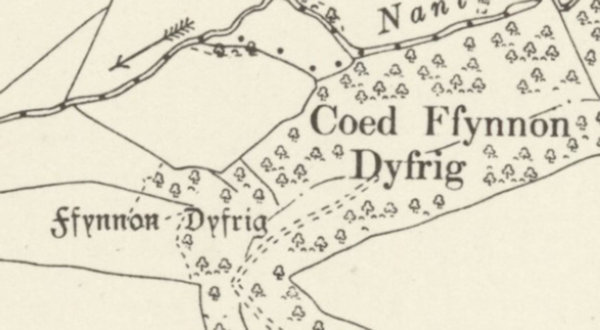 |
Dedication: Saint Dubricius Location: Walterston Coordinates: 51.437350N, -3.3477003W Grid reference: ST064717 Heritage designation: none |
 |
Dedication: Saint Dubricius Location: Walterston Coordinates: 51.437350N, -3.3477003W Grid reference: ST064717 Heritage designation: none |
St Dubricius, who is commonly called Dyfrig or Ddyfrig, was a 6th century saint from the area around Llandaff. He was born in Madley, Herefordshire (which is only ten miles from what is now the Welsh border) as the illegitimate grandson of King Peibio, the King of Ergyng, a kingdom that included part of south western Wales and much of eastern Herefordshire. The Vita S. Dubricii was written as part of the Book of Llandaff in 1120, in endorsement of a claim that had been made by Bishop Urban (the then Bishop of Llandaff) that Dyfrig had been ordained as the first Bishop of Llandaff by the famous St Garmon; this coincided with the translation of Dyfrig's relics from Bardsey Island to Llandaff in the very same year. The Vita S. Dubricii details the many miracles that were, from very soon after Dyfrig's death, attributed to him, including a story in which, as an almost newborn child, he cures his grandfather of a strange disease that causes him to dribble saliva perpetually. The claims of Bishop Urban that Dyfrig was the first Bishop of Llandaff are questionable, although that is not to say that they are incorrect. It is worth noting that Ffynnon Dyfrig is located just over five miles from Llandaff, and less than a mile from the village of Dyffryn, the name of which very possibly derives from "Dyfrig"; apart from anything else, these two factors certify that the holy well had direct links to Dyfrig's cult in the medieval era.
The earliest reference to the Ffynnon Dyfrig that I personally could find was made by Thomas Price in 1842 in Hanes Cymru, a Chenedl y Cymru:
|
Dywedir ei fod yn byw yn y Garnllwyd, a bod ffynnon gerllaw, yn dwyn ei enw; sef Ffynnon Ddyfrig. Translation: It is said that he [Dyfrig] lived in the Garnllwyd, and that there is a well nearby, that bears his name; namely Ffynnon Ddyfrig. |
The Garnllwyd that Price refers to appears to be the name of a small woodland in nearby Llancarfan, which itself takes its name from a small farm. Both of these features are located around a hundred metres away from the well. It is quite plausible that Dyfrig spent some time in the area, possibly as a hermit. In fact, in The Lives of the British Saints, which was written by Sabine Baring-Gould between the years of 1872 and 1877, Ffynnon Dyfrig is stated to be located "at Garn Llwyd, opposite Llanfeithin, about a mile from Llancarfan".
Although it appears that the well was at one time believed to have curative powers, the specific beliefs that were evidently once associated with Ffynnon Dyfrig are now lost to time. The remarks of a Mr T. E. Morris, who was commenting on John Rhys' paper, Sacred Wells in Wales, were published in volume 4 of the Folklore magazine in 1893, and reference the well:
|
I remember being at Llancarvan in July 1887, seeing the church, and visiting two old farmhouses with ecclesiastical traditions, Llanveithin and Gard Lwyd. I was then told that there was a Ffynnon Ddyfrig (St. Dubricius' Well), or a well with a similar name, about a mile off, if I remember rightly, the waters of which possessed healing properties. Unfortunately, my time was limited, and so I was unable to go and see it. |
In 1858, the Rev John Parry wrote about Ffynnon Dyfrig in Gwyddoniadur Cymreig:
|
Heb law hyny, sefydlodd Garmon athrofa enwog arall yn Llancarfan, neu Llanfeithin, yn sir Forganwg, a gwnaeth Ddyfrig Beneurog (Dubricius), gwr dysgedig a duwiol o Abergwaun, yn ben rhaith yn hono. Yr oedd Dyfrig yn trigiannu y pryd hwn yn y Garnllwyd, ac y mae ffynnon yn y lle hwnw, a elwir "Ffynnon Ddyfrig," hyd y dydd heddyw. Translation: Besides that, Garmon founded another famous institute in Llancarfan, or Llanfeithin, in the county of Glamorgan, and made Ddyfrig Beneurog (Dubricius), a learned and pious man from Abergwaun, its head. Dyfrig was living at this time in Garnllwyd, and there is a well in that place, called "Ffynnon Dyfrig," to this day. |
The current condition of Ffynnon Dyfrig today is not certain. The only information that the Coflein database provides about the site is a statement that the well consists of "traces of a stone-rubble strcture [sic], about a recess in the hillslope from which a spring issues". This comment is dated "28.01.03"; it is likely that the "03" refers not to 2003 but to 1903. The well is still marked and named on Ordnance Survey maps, as it always has been, so presumably it is still extant.
|
Access: The spring is located in the middle of a private woodland. |
Images:
Old OS maps are reproduced with the permission of the National Library of Scotland
Copyright 2025 britishholywells.co.uk